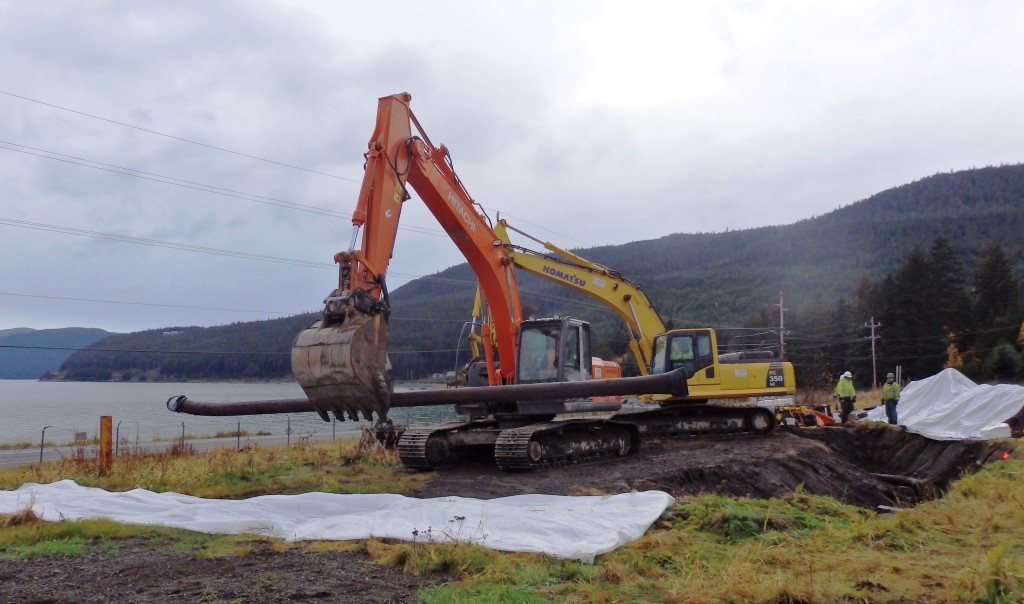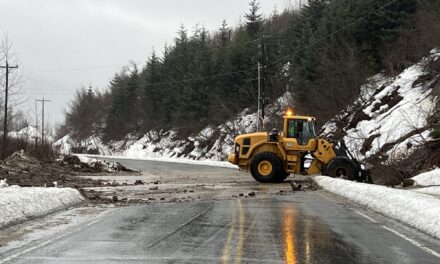The U.S. Army is working to assess contamination that has lived in the soil and groundwater at the former Haines tank farm and fuel terminal for decades. The contamination happened during the operation of the Haines-Fairbanks pipeline. The pipeline was built by the Army in the 1950s to supply fuel to military bases in interior Alaska.
In the past 20 years, the Army conducted dozens of surveys and studies at the now-defunct fuel terminal. But the piecemeal effort never resulted in a full-fledged assessment and clean-up. The Army hopes the work happening now will do just that.
“So he’s gonna swing around and snip it with his excavator arm,” Brian Adams, an environmental protection specialist with the Army, described the scene as workers remove a section of pipeline from the ground it’s been in for 60-plus years.
“Within the tank farm and mainline pipe, there’s about 14,000 linear feet of pipe,” Adams said. “They’ve removed about 5,000 or 6,000 feet of pipe already.”
The contractors at the fuel terminal did the pipeline-removal demonstration for a couple members of the local restoration advisory board. Most of the recent work has been in tank farm area, but the demonstration took place in what Adams calls the ‘admin area.’
“It’s purely safety, there’s far too many trenches up there, there’s far too many holes they’ve dug trying to get to the pipeline and trying to remove the pipeline,” Adams said.
He says that’s why KHNS News wasn’t able to see the work that’s happened over the past six months at the tank farm. But Adams says a central piece of it is testing for contamination. Contractor North Wind, Inc. is drilling holes in the ground using ultraviolet screening technology to test for soil and water contaminants across the tank farm.

Environmental protection specialist Brian Adams holds a flag that marks one of the soil testing sites. (Emily Files)
“They’re punch UVOST holes into the ground and it’s just a rod and it’s got a laser in it,” Adams said. “That laser sends out a signal and as it passes through the soil column that it’s entering it’ll read what’s there.”
The laser refracts off contaminants, like petroleum, in the soil.
“What happens is when they hit a hot spot, they would take that hot spot and they might put in a sampling well,” Adams said. “It’s just a hollow stem that’s pushed to a certain depth and they take water samples.”
They’ll use the data to determine the extent and nature of the contamination and the risk it poses to the environment and people.
Department of Environmental Conservation project manager Anne Marie Palmieri says what happens next really depends on what kind of contamination they find and how much there is. If it’s just petroleum, that will be easier to clean up and the Army will have to go through a less intensive process. If there are more toxic contaminants, it’s a different story.
Right now, Adams can’t talk about what they’ve found because the work isn’t finished, but…
“I’ll be honest in that we’re finding some contamination in places that we’re not expecting to find it, and we’re not finding it in places we would expect to find it,” Adams said. “So as my friends would like to say, the more I learn about the site, the more confused I get.”
Is that concerning?
“It’s not concerning, it’s just confusing,” Adams said. “I mean, it’s there, we know that it’s there. What’s confusing is how it got there, how it got from this point over here to that point over there when the ground water is this way. It’s just a matter of…we have to find it and we have to understand it before we get into the end clean-up.”
That clean-up is a long time coming.
“In the past [the Army has] conducted numerous investigations at different tank locations,” DEC’s Palmieri said. “But they haven’t looked at it as the entire site together and how it all fits together.”
Haines residents will have the chance to learn about the initial results later this year. The Army is planning to hold an advisory board meeting in early or mid-December.
“So they’ll be able to draw somewhat accurate circles on a map to say where the contamination is and where it isn’t,” Palmieri said.
Then, in 2016 and beyond, the Army plans to come up with a process to finally clean up the contamination that’s polluted sections of the old tank farm for decades.











